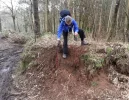This is the worst advice on pole use that I have seen for many years. There are at least two reasons why I say this:
- First, not using the pole straps correctly, ie with your hands completely through them, will mean that should you trip and stumble the poles will be substantially less assistance to you in recovering your balance. Why, because without the support of the straps, your only option will be to grasp the pole firmly. If you think about this, you will realize that not only will this require much more strength in your wrists and arms, but it will also require superb reaction times.
- Second, I suggest that walkers are less likely to fall and stumble in ways that would generate sufficient force to dislocate or fracture their bones than, for example, cross country skiers, who do reach speeds where pole related injuries occur. Indeed, if the fall was going to involve an impact with the force that would result in these injuries with a pole, then there is going to be a significant risk of injury without a pole, or with the pole used incorrectly. Any pole is going to help recover one's balance, and in doing so help avoid the injury. Alternatively, if the fall cannot be avoided, proper use of the strap is more likely to reduce the forces associated with the fall significantly, and even when balance cannot be recovered, reduce the risks of injury, not aggravate those risks.
I am aware that this is an anecdote, and not evidence, but in the one case about which I am personally aware on the camino, the person involved stumbled coming down the hill just before Zubiri. The forces on the pole were sufficient to bend the centre pole section - a result the local distributer claimed was impossible until they saw the pole. This person did sustain minor wrist injuries, which cleared up over the next few days. He believes that he would have sustained far more severe injuries had he not been using the poles straps properly.
@KenProudler, while I have not looked at more recent data, when I researched this a couple of years ago, I could not find any evidence that walkers using poles were suffering the sorts of injuries you are suggesting. The injury reports that I did find were from cross country and downhill skiing accidents, not walking. If you have any information that this has changed, perhaps you could share that information with us.
Finally, for the Pacer pole fraternity, let me suggest that in the absence of any evidence, this is just scaremongering. It does you no credit to jump on this as a reason to suggest Pacer poles have some supposed advantages.
























